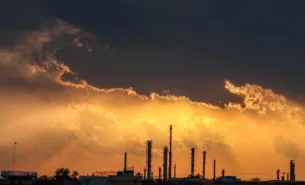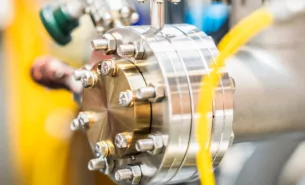Catalytic materials are found across industry and in most production of household chemicals, fuels, and in the cleaning of vehicle exhaust. When trying to understand and optimise a process, all the attention is usually put towards the surface of the catalytic material. A recent study shows, however, that what happens in the layers under the surface may be even more essential.
Catalysts are used to facilitate chemical reactions that otherwise would have been too slow to be practical, if at all possible. The most well-known example of a catalyst is the metal particles found inside the catalytic converter of a fossil-fuelled car. The exhaust gasses react on the surface of the metal particles and become less toxic.
In the present study, a research team used MAX IV to investigate the oxidation of methane on the surface of the catalyst palladium.
“Methane is an important constituent in natural gas, and unburned methane is often released from combustion engines. Since it at the same time is a potent greenhouse gas it has to be removed before the exhaust. This is often done via palladium-based catalysts,” says Ulrike Küst, one of the authors of the study.
The researchers conclude that the efficiency limiting step of the catalytic reaction does not take place on the surface but is the transport of carbon into the layers below it. Excess carbon can get from the surface and into the subsurface layers. When the subsurface layer gets filled with carbon to capacity, any excess carbon atoms will instead start covering the surface, slowing the catalytic reaction down.
“We were surprised that we could then even observe reversible subsurface carbon diffusion,” says Ulrike Küst.

In their experiment, the researchers let a gas mixture of methane and oxygen flow over the platinum catalyst, while heating it to different temperatures. The team then used X-rays with different wavelengths to probe different depths below the surface of the palladium and could follow the faith of the oxygen and carbon from the incoming gas mixture. The experimental technique is called time-resolved ambient pressure X-ray Photoelectron Spectroscopy (tr-APXPS).
They found that the temperature-dependent transport of carbon from the surface into the subsurface layers decides how much methane can be converted over time, the turnover. The carbon coverage of the surface dictates selectivity, that is what reaction products are formed.
“The direct connection between the selectivity and surface carbon, and the connection between surface carbon formation and subsurface carbon was interesting”, says Küst.
The result is a step forward towards engineering a more efficient palladium catalyst by modifying the subsurface layers to be able to transport or hold more carbon there.
“Our work is fundamental in nature. But a fundamental knowledge of how surface and subsurface carbon affects the function of the catalyst is important to be able to propose design strategies for the development of new superior catalyst materials. In fact, carbon deposition takes place in many catalyst materials making our study relevant for many catalyst systems,” concludes Küst.




